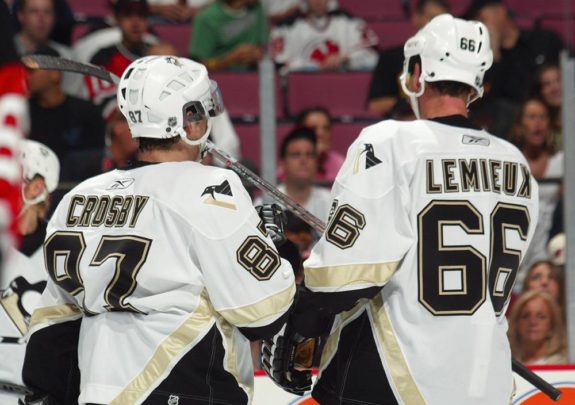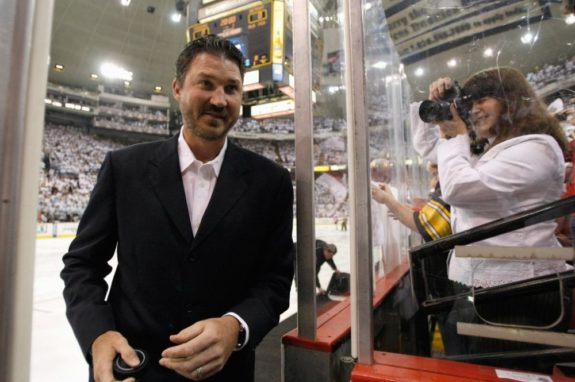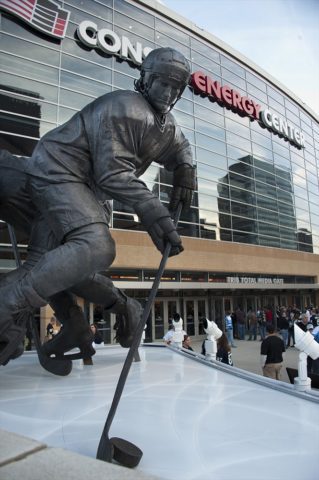This article was originally written in December, 2012.
In 1997 the National Hockey League lost one of the greatest players to ever play the game early. Mario Lemieux didn’t pass away during his career, nor did he decide to go out on top. No, the announcement Super Mario made was for different reasons and will always leave us wondering what could have been, had played a full career.
Lemieux left the game for a variety of reasons and just months later was inducted into the Hockey Hall of Fame, becoming just the ninth player in history to have the three-year waiting period waived. He claimed that chronic back injuries and the constant physical abuse were to blame for his departure and it’s hard to argue after what the then 32-year-old battled during his 12 seasons in the NHL.
The Reasons for Lemieux’s Retirement
At 28, there wasn’t much Lemieux still needed to accomplish. He had taken the Pittsburgh Penguins from league laughing stock to back-to-back Stanley Cup champion in eight seasons, winning a Calder Memorial Trophy, two Hart Trophies and four Art Ross Trophies along the way – despite battling several back injuries. But while in the midst of the Penguins defense of the Stanley Cup, Lemieux announced he had been diagnosed with Hodgkin’s lymphoma, a debilitating form of cancer that affects the body’s white blood cells. His career was suddenly in jeopardy – but more importantly, his life was in jeopardy.

After taking a season and a half off, Mario Lemieux returned to the Penguins on the day he completed his radiation treatment and continued to perform as though he had never missed a beat. The radiation and the time off proved to be important as he had beat the cancer, however the injuries returned with frequency. He decided to retire at the end of the 1996-97 season, noting chronic injuries and the physical abuse of the game as the reasons. After beating cancer, the retirement came as a bit of a surprise since he was still in his prime, tallying 119 goals and 164 assists in his final two seasons. During his last game – a playoff loss on the road to the Philadelphia Flyers – Lemieux skated around the ice after the final horn and was given a standing ovation by rival fans. Even the opposition knew how important “Super Mario” was for the NHL.
But he wasn’t done leaving his impact.
The Continuing Impact of Lemieux
After a rollercoaster career filled with injuries, most players probably would have disappeared for awhile and enjoyed the finer things in life – not Lemieux. With all of the Penguins’ success in the early 1990s, the team had spent itself into a hole. Suddenly, the team’s leader on the ice became its leader off of the ice. Since Lemieux was owed upwards of $30 million in deferred salary, he proposed a plan to convert his money owed into equity and buy the team. The move made him the first former NHL player to become majority owner of his former team.

Being in charge of the Penguins’ day-to-day activities must have reminded Lemieux how much he missed the game and by 2000 the league was filled with the rumors of a possible return. It filled league headlines and in Pittsburgh it was the biggest news since his departure three years earlier. The rumors circulated for months, much to disbelief of many but on Dec. 11 Lemieux announced his plans to end his retirement and once again become an active NHL player. 16 days later he made his return at home against the Toronto Maple Leafs, in a game that was nationally televised throughout the United States and Canada.
Lemieux’s Return
Lemieux was welcomed back with a standing ovation, his number displayed on the outside of Mellon Arena and 17,132 fans holding Mario signs. It didn’t go unnoticed as he notched an assist just 33 seconds into his first shift. He still had it.

He finished the game with a goal and two assists but it left a bigger mark on the NHL. It was the first time in league history that an owner was also an active player on his own team. He finished the season with 76 points in just 43 games and was even nominated for the Hart Trophy. Lemieux rejuvenated the scrappy Penguins, who surprised many after beating the higher-seeded Washington Capitals and Buffalo Sabres before falling to the New Jersey Devils.
Shortly after, the injuries returned. Lemieux put up typical numbers when he was healthy but it was a struggle for him to remain on the ice. He never played a full season after his return to the game – plus he missed out on an entire season due to the lockout in 2004-05. But it was during that time that Lemieux found his successor.
The Penguins selected Sidney Crosby first overall in the 2005 draft, 21 years after choosing Lemieux. There hadn’t been a player as highly-touted as Crosby since the 1990s and Lemieux knew he had found the piece to build his team around. He brought in veteran talent to play around Crosby and even had Crosby stay at his house during his first year in the league, in the hopes of helping him blossom as a player. Both were on the same line, which was arguably the most exciting in the NHL – well for 26 games at least. Lemieux was sidelined with an irregular heartbeat, as the injuries had finally caught back up to him, forcing him to announce his retirement on Jan. 24, 2006.
Lemieux Now
He might no longer score goals on the ice, but now Lemieux is building a championship-caliber hockey team for Pittsburgh and in 2009 he won his third Stanley Cup as the owner of the Penguins. It’s certainly been a full career for a guy who missed out on much of his prime.